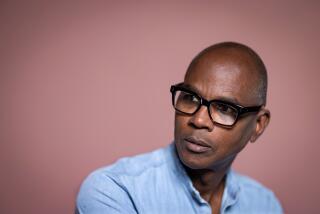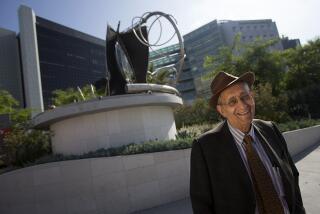Hans Burkhardt; Leading Protest Artist
Hans Burkhardt, the much-honored Swiss-born artist whose protest paintings grew from the Dickensian squalor of his youth, died Friday. Burkhardt, whose subjects ranged from the divisiveness of the Spanish Civil War, the millions of dead in World War II and the horror of My Lai in Vietnam to the recent campaigns of Desert Storm, died at his home in Los Angeles, said Jack Rutberg, his agent and biographer. He was 89.
Described by Times art critic William Wilson “a classic American-immigrant success story,” Burkhardt spent his boyhood hungry and cold in a Basel city orphanage.
In 1924, he wearied of the poverty and took his innate artistic talent to New York, where he came under the influence of abstract expressionist Arshile Gorky.
Besides the opportunity to express himself as he wished, Burkhardt told The Times in 1992--just before being honored with a lifetime achievement award from the American Academy and Institute of Arts and Letters--he was amazed that “in the U.S., you have a decent meal every day.”
He studied and lived with Gorky and associated with Willem de Kooning.
Gorky committed suicide in 1948, a decade after Burkhardt had moved to Los Angeles, where he lost what little he had in a divorce settlement.
“Afterward, I hung the clerk of the Domestic Relations Court in a painting. It was my first protest painting.”
That set him on a path that was to make him a leader in socially conscious art. Conversely, however, his other works portrayed optimism and hope in a dichotomy that Burkhardt said reflected his own divisive feelings.
His oils and pastels were featured in Art News and Artspace magazines. He had his work shown at prestigious exhibits in Mexico and was included in the 1955 U.S. presentation at the 3rd Biennial of Sao Paulo.
But he also had such controversial works as “Red Christ” barred from jury consideration at the Los Angeles County Museum; a protester used a cane to strike Burkhardt’s “War, Agony and Death,” which was also slashed twice.
Wilson noted that in the same year Burkhardt won the county museum’s annual juried show prize for his painting “One Way Out,” the museum “inexplicably refused to show” the work.
His protest art first came to light with such works as “Concentration Camp” and “The Death of Hitler.”
In 1945, he joined a widespread film studio strike and from that painted “Studio Scab--Ronald Reagan.”
Shortly afterward he moved to Mexico for several years, and later said although “I love this country,” (the United States) Mexico is “where life and death live close together and people aren’t afraid of it.”
Returning to this country in the late 1950s, Burkhardt taught at Cal State Long Beach, UCLA, USC and the Otis and Chouinard institutes and others.
He painted tributes to such fallen leaders as John and Robert Kennedy, Martin Luther King Jr. and the students at Kent State University who died protesting the Vietnam War.
A retrospective of his work is on exhibit at the Jack Rutberg gallery on North La Brea Avenue.
Burkhardt is survived by a daughter.
More to Read
The biggest entertainment stories
Get our big stories about Hollywood, film, television, music, arts, culture and more right in your inbox as soon as they publish.
You may occasionally receive promotional content from the Los Angeles Times.










